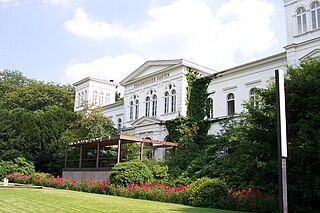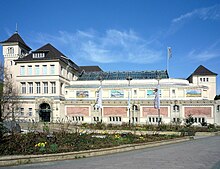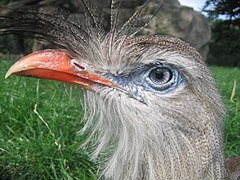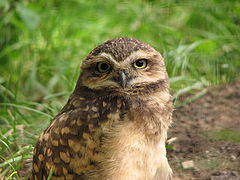London Zoo, previously known as ZSL London Zoo or London Zoological Gardens and sometimes called Regent's Park Zoo, is the world's oldest scientific zoo. It was opened in London on 27 April 1828, and was originally intended to be used as a collection for scientific study. In 1831 or 1832, the animals of the Tower of London menagerie were transferred to the zoo's collection. It was opened to the public in 1847. As of December 2022, it houses a collection of 14,926 individuals, making it one of the largest collections in the United Kingdom.

Schönbrunn Zoo is a 17-hectare (42-acre) zoo in the city of Vienna, Austria. Established in 1752, it is the world's oldest zoo still in operation. It is also a UNESCO World Heritage Site, being a part of the Schönbrunn Palace gardens. It generally receives more than 2 million visitors every year.

Hellabrunn Zoo is a 40 hectare zoological garden in the Bavarian capital of Munich. The zoo is situated on the right bank of the river Isar, in the southern part of Munich near the quarter of Thalkirchen.

Beijing Zoo is a zoological park in Xizhimen, Xicheng District, Beijing. Founded in 1906 during the late Qing dynasty, it is the oldest zoo in China and oldest public park in northern China. The zoo is also a center of zoological research that studies and breeds rare animals from various continents.

Prague Zoological Garden is a zoo in Prague, Czech Republic. It was opened in 1931 with the goal to "advance the study of zoology, protect wildlife, and educate the public" in the district of Troja in the north of Prague. In 2013, the zoo occupied 58 hectares with 50 hectares in use for exhibits, and housed around 5,000 animals from 676 species, including 132 species listed as threatened.

The Aktiengesellschaft Cologne Zoological Garden is the zoo of Cologne, Germany. Being the third oldest zoo in Germany, it features over 10,000 animals of more than 850 species on more than 20 hectares. The internationally renowned zoo with an attached aquarium and invertebrate exhibit is active in preservational breeding of animals that are in danger of becoming extinct. In addition, in-the-wild conservation efforts and research focussing on animals of Madagascar, Wallacea, and Vietnam are actively promoted and supported via cooperation with Cologne University and local projects, such as in the case of Przewalski's horses.
The Duisburg Zoo, founded on 12 May 1934, is one of the largest zoological gardens in Germany. It is especially well known for its dolphinarium and, since 1994, for breeding koalas.

Wuppertal Zoo is a 24-hectare (59-acre) zoo in Wuppertal, Germany. About 5,000 animals from around the world live at the zoo, representing about 500 species, including apes, monkeys, bears, big cats, elephants, as well as birds, reptiles, and fish.

The ménagerie du Jardin des plantes is a zoo in Paris, France, belonging to the botanical garden Jardin des Plantes. Founded in 1794, largely with animals brought from the royal zoo of the Palace of Versailles, abandoned because of the French Revolution, it is the second oldest zoological garden in the world. Today, the zoo contains many rare smaller and medium-sized mammals, and a variety of birds and reptiles.

The Tierpark Berlin is one of two zoos located in Berlin, Germany. It was founded in 1955 and is located in Friedrichsfelde on the former grounds of Friedrichsfelde Palace, which is situated within the zoo. As of 31 December 2013, the zoo houses 7,250 animals from 846 species, in an area of 160 hectares. Tierpark Berlin also features two public exhibits free of charge, one being the Bärenschaufenster for American black bears. The park is also home to the Treskow family's historic family burial ground.

The Zoological Garden of Hamburg was a zoo in Hamburg, Germany that operated from 1863 until 1930. Its aquarium, which opened in 1864, was among the first in the world.

The Chengdu Research Base of Giant Panda Breeding is a public non-profit breeding and research institute for giant pandas, red pandas, and other rare animals, located in Chengdu, Sichuan, China.

The Karlsruhe Zoo is a city garden with a zoo in the southwest of Karlsruhe, Germany. It also encompasses the outer area; Tierpark Oberwald in the southeast of the city. The main area totals 22 hectares, and the Oberwald Zoo has an area of 16 hectares. A total of around 3000 animals of over 240 species live at the Zoologische Stadtgarten Karlsruhe. The city garden is located north of the Karlsruhe Hauptbahnhof and south of the Karlsruhe Congress between the Karlsruhe districts of Südstadt and Südweststadt. The zoo was opened in 1865, making it one of the oldest zoos in Germany. The city garden and zoo form a common, enclosed area and cannot be visited separately.
As of 2019, there are 27 zoos in 21 countries outside of mainland China, that have giant pandas. These zoos have contracts with China to house these pandas for a few years. The two exceptions are the three pandas held at Taipei Zoo, which are owned by the Taiwanese government, and one panda held in Mexico. Giant pandas are on the IUCN Red List so part of the reason these contracts exist between China and international zoos is to try to help the species reproduce before they are brought back to their native land. For this reason, pandas are treated very well.

Rostock Zoo is a zoo in the city of Rostock, founded in 1899. It covers 56 hectares and with 4,500 animals from 320 species, Rostock Zoo is the largest zoo on the German east coast. Rostock Zoo is studbook keeper of Polar bears within the European Endangered Species Programme. The director of Rostock Zoo is Udo Nagel.

Zoo Osnabrück is located in south Osnabrück at the hillside of Schölerberg in Osnabrück, Germany. It was founded under the name "Heimattiergarten", and opened during the summer of 1936. Almost 3000 animals from roughly 300 species can be seen on the 23.5 ha (0.235 km2) land. It is famous for housing the Grolar Bear. This brought about many scientific inquiries into the zoo.

Magdeburg Zoo is a zoo in the city of Magdeburg in the region Sachsen-Anhalt, Germany. The zoo was founded in 1950, and covers 16 hectares.

The Saarbrücken Zoo is with over 200.000 visitors annually, and over 1.700 animals from 160 Species the largest Zoo in Saarland. The Zoo is specialized in African animals.

The Chemnitz Zoo is a zoo in the city Chemnitz in Sachsen, Germany.
The Verband der Zoologischen Gärten, until 2014 Verband Deutscher Zoodirektoren, is the leading association of scientifically managed zoological gardens in German-speaking countries. A zoo is considered to be scientifically managed if it is run by a director with an academic education, usually a biologist or a veterinarian, and if he or she follows and implements scientific standards of zoology, conservation, and zoo pedagogy.









































